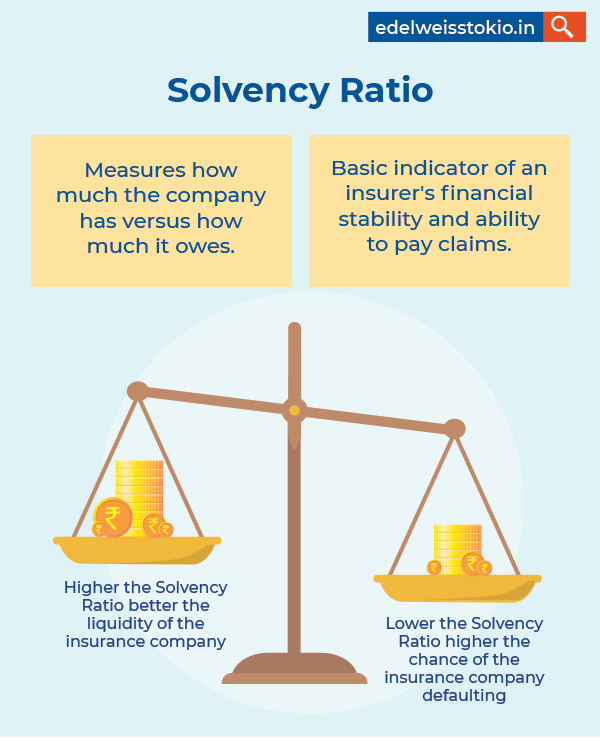All About Solvency Ratio for Life Insurance
Blog Title
10169 |
What is Solvency Ratio in Life Insurance?
The solvency ratio of an insurance company is how much capital it has compared to the risk it has taken on. The risk is calculated by subtracting liabilities from total assets. In other words, solvency measures how much the corporation has versus how much it owes. It is a basic indicator of an insurer's financial stability and ability to pay claims. Investors can use it to see if the company can meet its obligations, like a bank's capital adequacy ratio.
It is important to note that solvency and liquidity are not synonymous. Liquidity shows if a company can pay short-term debt. Solvency shows if it can pay all debt, including long-term debt. It indicates the firm's long-term viability.
Key Takeaways:
Solvency ratio is an important parameter to consider when choosing an insurer as, in case of your unfortunate demise,
- An insurance company with a low solvency ratio might postpone or struggle to pay you or your family.
- On the other hand, an insurance company that has a high solvency ratio will provide compensation to you and your family.
How is Solvency Ratio Calculated?
The calculation of the solvency ratio uses the following formula:
Solvency Ratio = (Net Income + Depreciation) / Liabilities
The solvency ratio formula compares a company's cash flow against the money it owes as the total sum assured. The higher the solvency ratio, the more assets there are compared to obligations.
Why is Checking the Solvency Ratio Important?
When buying a life insurance plan, it's important to check the solvency ratio of the company. This ratio shows how much money comes in and out, as well as the company's overall liabilities. The ratio helps customers choose insurance companies that handle claims and financial responsibilities appropriately.
Higher solvency ratios mean it's more likely to pay claims and handle financial costs. The higher the solvency ratio, the better it is for policyholders as well. However, if the solvency ratio is low, the insurance company may struggle to meet financial obligations and pay claims at the same time.
Insurance companies receive innumerable claims regularly. Hence, paying claims and taking care of other financial responsibilities requires suitable financial capabilities.
Let's look at an example to see what it means:
Neha obtained a life insurance policy from an insurer. In case of her unfortunate demise, the insurance company promises to pay a sum assured as the death benefit to her nominee(s). Let's say such a tragedy comes to pass, and her nominee files a claim. If the company's solvency ratio is low, then it might struggle to make the payout, as the number of claims at any given point is always high. Thus, to ensure that your nominee is financially secure in your absence, you must check the solvency ratio of the insurance company, among other factors.

What is the IRDAI's Mandate on Solvency Ratio?
The IRDAI marks solvency ratio as a key parameter for insurance companies, mandating the maintenance of a ratio of 1.5 for every insurance company with a solvency margin of 150%. It is something that every insurer should abide by. Yet, even within these limits, individual life insurance providers differ in their ranking. To find the best life insurance company for you, check the solvency ratios of all registered insurers on the IRDAI website's annual report.
Customers should always check the solvency ratio with care if they purchase insurance. It matters since the inability of an insurance company to settle claims swiftly and tackle financial responsibilities defeats the core purpose of insurance on multiple levels.
While the Claim Settlement Ratio and Turn Around Time are vital aspects to consider when selecting an insurance company, you should also keep the Solvency Ratio in mind. A term insurance policy is your way of ensuring your family's future in your absence. So, make sure you make an educated decision before purchasing any insurance policy.
FAQs
What is a reasonable solvency ratio for an Insurance Company?
As per the requirements of IRDAI, insurance companies must maintain a solvency ratio of 1.5. Anything higher than this is considered a good solvency ratio.
What is liquidity ratio or solvency ratio?
Liquidity and Solvency are two separate parameters. While Liquidity is the ability of an insurer to pay off short-term liabilities, Solvency takes into account long-term debts as well.
Is a high solvency ratio good or bad?
High solvency ratio is an indicator of an insurer’s good financial health. You should choose an insurance company with a high solvency ratio.
Chirag Iyer - BFSI Enthusiast
Chirag is a writer and an avid reader who loves to drink coffee! His other interests include boxing, karate, and singing.












